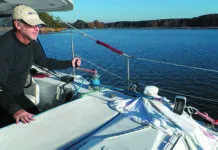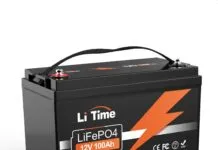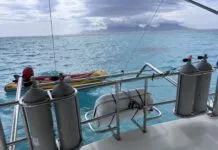Electric-Flush Marine Toilets Part 2
Practical Sailor evaluated 14 electric marine toilets from seven manufacturers. This article is a follow-up to the February review of seven compact electric toilets; it focuses on the seven larger, heavier, more expensive test toilets, which are similar in size to standard household toilets. Part 2 of the toilet test report included heads from Dometic, Jabsco, Planus, Raritan, Thetford, and Tecma. These heads, equipped with more sophisticated flushing systems than those previously tested, are best suited to boats over 40 feet. Testers looked at the toilets' varying approaches to macerators, flow valves, and plumbing. The bench tests also evaluated noise levels during flushing, construction quality, ease of installation and maintenance, time to flush 1 gallon of water, and macerator performance.
Practical Sailor Tests Electric-Flush Marine Toilets
Practical Sailor compared the style, performance, weight, and ruggedness of 7 electric-flush marine toilets from four manufacturers. Once considered a luxury made only for the megayacht crowd, electric marine heads today are more compact, more reliable, and less expensive than their predecessors, making them viable options for amenities-seeking cruisers. In tests, PS compared the flow rate of the supply pumps, the amps used per flush, the time it took each toilet to flush, and the efficiency of each toilet to manage the material flushed. The test field included the Raritan Sea Era, the Raritan Marine Elegance, the Jabsco Quiet Flush, Jabsco Deluxe Lite Flush, the Johnson Aqua-T, and the Groco Type K 12-volt marine electric-flush toilet.
How to Prevent Head Odors Aboard Your Sailboat
While permeation of waste gases through flexible sanitation hose is a major source of odors in the head, it is not the only one. This article looks at the possible sources one by one.
Going Bananas? Go Sailing
The back of our workshop in Sarasota, Fla., is crowded with paints and thinners, rags and brushes, dusty pallets and power tools, and now, a small mountain of electric flush toilets. Since I have a long-running feud with manual toilets, I don't deserve nor want an electric-flush version. But there are apparently plenty of readers who are contemplating push-button porcelain thrones, and who am I to deny them this indulgence?
Boat Holding Tank Sensor Long-term Test Update
Last year, Practical Sailor installed and tested seven internally mounted liquid-level monitoring kits, including the sensors and their mated remote display panels, in a polyethylene holding tank; the results were reported in the May 2008 issue. The sensors spent the following nine months marinating in the tank, with the occasional sloshing by a tester, before being re-tested to see how well they continued to perform. The test field comprised float sensors, neumatic sensors, and an ultrasonic sender. Float sensors included Sealand TankWatch1, Dometic DTM4, Groco TLM Series, and Wema SHS-8. Air-pressure-fueled sensors included Fireboy-Xintex PTS and Hart Systems Tank Tender. BEP Marines (Marinco) TSI sender uses ultrasonic pulses to measure liquid levels.
Conversion Kits that Turn Your Boat’s Ice Box Into a Galley Refrigerator
Practical Sailor tested three kits that convert onboard ice boxes into full-fledged refrigeration systems. The three reefer conversion kits in the review-the Waeco-Adler Barbour Cold Machine (CU 100) from Dometic Corp., the Frigoboat Capri 35F by Veco SPA, and the Sea Frost BD-represent a cross-section of whats available on todays refrigeration conversion kit market. Testers looked closely at energy efficiency and the 12-volt units abilities to cool a small ice box with the least amount of amp hours possible. Testers looked at quality, details, reliability, and cooling capacity.
Riffin on Foods that Need No Fridge
You might be surprised how well you can eat fresh without a fridge, even in the tropics. Onions and potatoes will keep for weeks (but not together, please). Lemons, limes, and oranges-especially those with thick skins-will survive for weeks. Fresh green tomatoes shrug off lumpy seas and still ripen nicely. Bananas don't like cold to begin with. Hang a green bunch from the backstay, and theyre happy. Be ready, though. They ripen fast . . . banana bread for breakfast! Rice and beans offer simple sustenance. Wrap them in a homemade tortilla, add a little hot sauce, and its Mexican Night. Wax balls of cheese, Parmesan wheels, and long sausage links turn the galley into a deli. Breadfruit is a born voyager, but taste best cooked over an open fire. (Baking is the safer choice while underway.) Coconuts last ages, but husk them ashore, where a long stake and machete can be wielded without harm. Big purple mangoes are hardier than the yellow varieties. Pick them when they bear a tinge of purple. Theres a secret to ripening a green papaya. (Tell me if you know what it is!) Or you can and shave a green one into a fiery Thai curry.
Marine Refrigeration: Traditional Thermostats vs. Digital Thermostats
Modern galley refrigeration moved far beyond simple holding-plate refrigeration systems, and now competes with the more easily installed evaporative refrigeration systems. One key to efficiency in any refrigeration system is an accurate thermostat. Practical Sailor compares a more expensive digital thermostat to a traditional, less expensive mechanical capillary thermostat. Refrigerator and freezer tests pitted the Grunert Marine Air Systems mechanical capillary refrigeration thermostats against the Scad Technologies SensiStat digital thermostat. Mechanical thermostats are valued for their simplicity and reliability, but a digital thermostat may outperform mechanical thermostats when it comes to maximizing marine refrigeration performance.
Next Best Thing
While world leaders and presumed financial wizards set to work trying to right the global economy with some very expensive bailers and sponges, Practical Sailor has taken the time this month to dig through our recent collection of Chandlery submissions to see if we can find anything more useful. Given sailors capacities for innovation (aka "jury rigging"), were holding out hope that the next great invention-the ultimate stimulus package-lies somewhere in our growing stockpile of Chandlery items.
Practical Sailor Puts Monster-Sized Coolers Through a Melt Down
Ice chests come in all shapes and sizes. And often times, sailors and fishermen will prefer keeping a large cooler aboard to installing a marine refrigeration system. So for this test, we narrowed the field to portable 65-quart coolers and a 70-quart cooler from Yeti, Engel, and Coleman. The three test products were the Engel ENG65, Yeti Tundra, and the Coleman Ultimate Extreme Marine. Testers compared the effectiveness of each cooler at keeping ice during a meltdown test: A six-pack of soda was covered with 16 pounds of ice and checked at 12-hour intervals. The top performer was the Engel, but testers deemed the Coleman a bargain as it was less than half the cost of the others.
















































